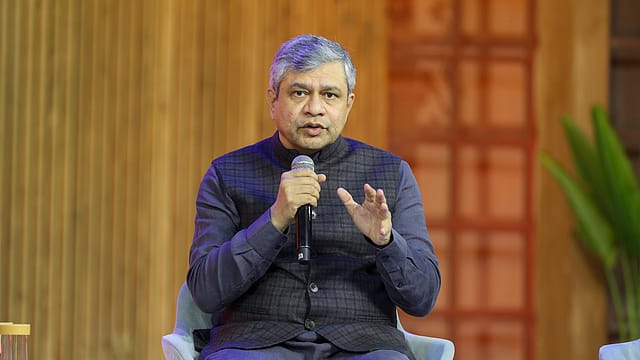Ashwini Vaishnaw's bold promise: India to have its own GenAI model soon
ADVERTISEMENT

As China receives global praise for the development of DeepSeek—an AI model challenging the dominance of OpenAI's ChatGPT— Union Minister for Electronics & IT Ashwini Vaishnaw has highlighted India's rapid progress in the AI space. He stated that within a short time frame, India has established the first major pillar of the India AI Mission: the Common Compute Facility. According to the minister, against a target of 10,000 GPUs, India has empanelled 18,693 high-end GPUs.
Vaishnaw’s comments came a day after he announced that India would soon have its own large language model (LLM). “Very soon, we will also have our own LLM. In the India AI compute facility, we have received computing resources to power 18,000 GPUs. Anyone looking to invest in an AI computing facility now has a platform through the India AI Mission,” he said at the Odisha Utkarsh summit on Wednesday.
Speaking at the AI India Mission press conference on Thursday, Vaishnaw said the government’s AI framework was being launched that day, with a focus on building AI models rooted in the Indian context and culture.
The India AI Mission, approved in March 2024, aligns with Prime Minister Narendra Modi’s vision for inclusive economic growth, he noted. “Since August 2024, we have created the first and biggest pillar of the India AI Mission—the Common Compute Facility. The empanelment process, completed last week, has yielded excellent results. Against a target of 10,000 GPUs, we have empanelled 18,693, and these are top-tier GPUs. Among them, 12,896 are H100s, 1,480 are H200s, and 742 are MI325 and MI300X GPUs,” he says.
December 2025
The annual Fortune 500 India list, the definitive compendium of corporate performance, is out. This year, the cumulative revenue of the Fortune 500 India companies has breached $2 trillion for the first time. Plus, find out which are the Best B-schools in India.
“To put this in perspective, DeepSeek was reportedly trained on 2,000 GPUs. This Common Compute Facility is a crucial component of the India AI Mission and reflects the Prime Minister’s commitment to democratising technology and fostering inclusive growth. Now, startups eager to develop foundational models will have the opportunity to create India’s own AI models, including LLMs, as well as sector-specific and application-specific models,” Vaishnaw says.
The minister reportedly also said the government plans to host DeepSeek on Indian servers, which will address data privacy concerns and power India's AI capabilities, reported Moneycontrol. He also said some have raised questions over spending on the India AI mission, but DeepSeek was able to make a really powerful model at just $5.5 million. "All thanks to smart planning," he said.
The minister emphasised that AI has the potential to address many large-scale challenges in India. To accelerate AI development, the government has initiated a call for proposals and will engage with startups, IT firms, academia, and researchers to create foundational AI models. “This will be a continuous process. Every month, proposals submitted by the 15th will be reviewed by a technical committee. The evaluation will be purely based on technical merit, similar to the approach taken in the semiconductor mission, which follows a techno-financial evaluation model. The selected proposals will then receive funding,” he explained.
Once these AI applications are developed, Vaishnaw said, they can address large-scale societal challenges. “For the first round of funding, 18 applications across three fields—agriculture, learning disabilities, and climate change—have been approved. Many more applications are in the pipeline.”
The minister also addressed AI safety concerns. “The AI Safety Institute is actively working on this. It operates as a virtual institute where any organisation interested in AI safety can participate. So far, eight projects have been approved under this initiative, and five new projects are now open for proposals. These focus on privacy, algorithmic integrity, defect detection, and other techno-legal issues.”
Meanwhile, as China's DeepSeek AI model disrupts the global AI landscape, some experts in India argue that the country must move beyond "short-termism" and adopt a long-term approach to building a robust AI ecosystem. Notably, DeepSeek performs on par with several advanced AI models developed by American companies, but at a fraction of the cost. While OpenAI and Google’s AI models cost around $100 million to train, DeepSeek’s latest model was developed for just $5.6 million. Venture capitalist and former adviser to US President Donald Trump, Marc Andreessen, described this development as "AI's Sputnik moment."
Empanelment of AI services on cloud
The government had approved the IndiaAI Mission with a Budgetary outlay of Rs 10,372 crore in March 2024. IndiaAI Mission is being implemented through 7 key pillars and one of the key pillars is enabling the availability of 10,000 GPUs for AI Compute Infrastructure. The Centre through IndiaAI Independent Business Division (IBD) had published a Request for Empanelment (RFE) on August 16, 2024, to empanel AI services on cloud and offer the services to academia, MSMEs, startups, research community, governments, public sector agencies and other entities approved by IndiaAI via the CPP portal.
19 bidders that included Cloud Service Providers (CSPs), Managed Service Providers (MSPs), and Data Center Service Providers submitted proposals. After initial scrutiny, 13 bidders were invited to make presentations to the technical evaluation committee. After the technical evaluation, 10 bidders were found to be eligible for opening of financial bids. The financial bids of the 10 technically qualified bidders were opened on January 22, 2025. The 10 bidders listed below have offered their commercials for various categories of AI compute units (GPUs) quoted.
CMS Computers India Pvt Ltd
Ctrls Datacenters Ltd
E2E Networks Limited
Jio Platforms Limited
Locuz Enterprise Solutions Limited
NxtGen Datacenter and Cloud Technologies Private Limited
Orient Technologies Limited
Tata Communications Limited
Vensysco Technologies Limited
Yotta Data Services Private Limited
